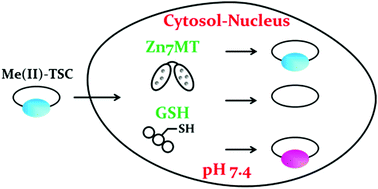Reactivity of Cu(ii)–, Zn(ii)– and Fe(ii)–thiosemicarbazone complexes with glutathione and metallothionein: from stability to dissociation to transmetallation†
Abstract
Thiosemicarbazones (TSCs) are a class of strong metal ion ligands, which are currently being investigated for several applications, such as anticancer treatment. In addition to these ligands only, which exert their activity upon interaction with metal ions in cells, preformed metal–TSC complexes are also widely studied, predominantly with the essential metal ions iron, copper and zinc. Currently, it is unclear what the active species are, which complexes are present and what are their biological targets. Herein, we study the complexes of copper(II), zinc(II) and iron(II) with three TSCs, PT, 3-AP (triapine) and Dp44mT, (latter two are currently in clinical trials), concerning their reactivity with glutathione (GSH) and Zn7-metallothionein (Zn7MT-1, 2 and 3). These two cysteine-containing molecules can have a major impact on metal–TSC complexes because they are abundant in the cytosol and nucleus, they are strong metal ligands and have the potential to reduce Cu(II) and Fe(III). Our results indicate that Fe(II)–TSC is stable in the presence of typical cytosolic concentrations of GSH and Zn7MT. In contrast, all three Cu(II)–TSCs react rapidly due to the reduction of Cu(II) to Cu(I), which is then transferred to MT. This suggests that Cu(II)–TSCs are rapidly dissociated in a cytosolic-type environment and the catalytic generation of reactive oxygen species by Cu(II)–TSCs is stopped. Moreover, in the case Cu(II)–Dp44mT, transmetallation with Zn(II) from MT occurs. The reaction of Zn(II)–TSCs is ligand dependent, from predominant dissociation for PT and 3-AP, to very little dissociation of Zn(II)–Dp44mT2. These results indicate that GSH and Zn7MT may be important factors in the fate of Cu(II)– and Zn(II)–TSCs. In particular, for Cu, its chemistry is complex, and these reactions may also occur for other families of Cu-complexes used in cancer treatment or for other applications.



 Please wait while we load your content...
Please wait while we load your content...